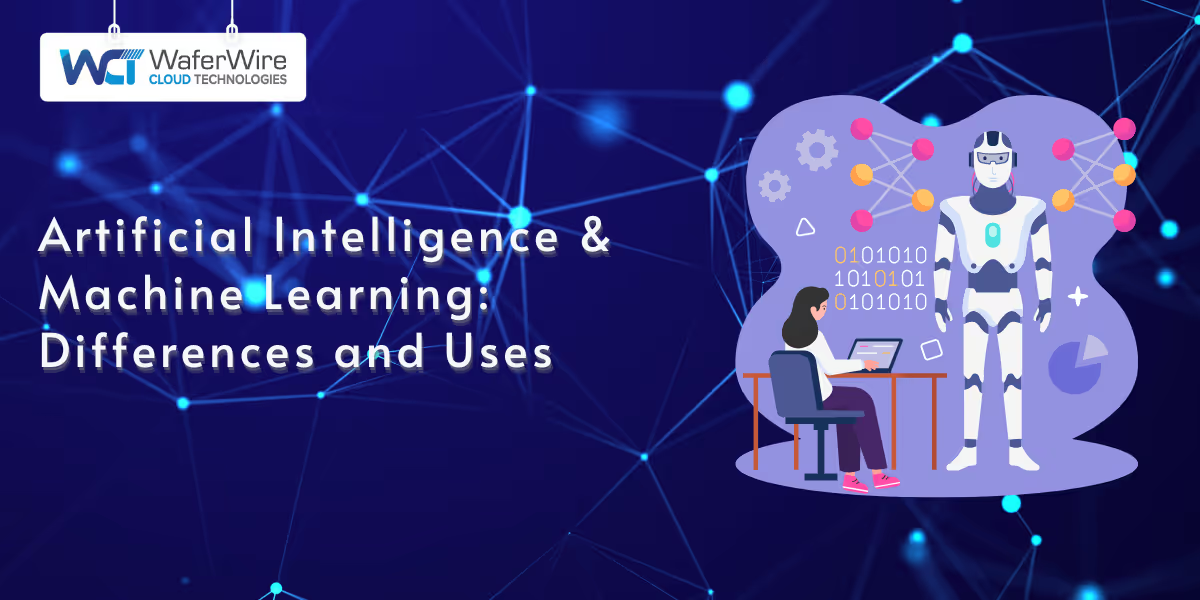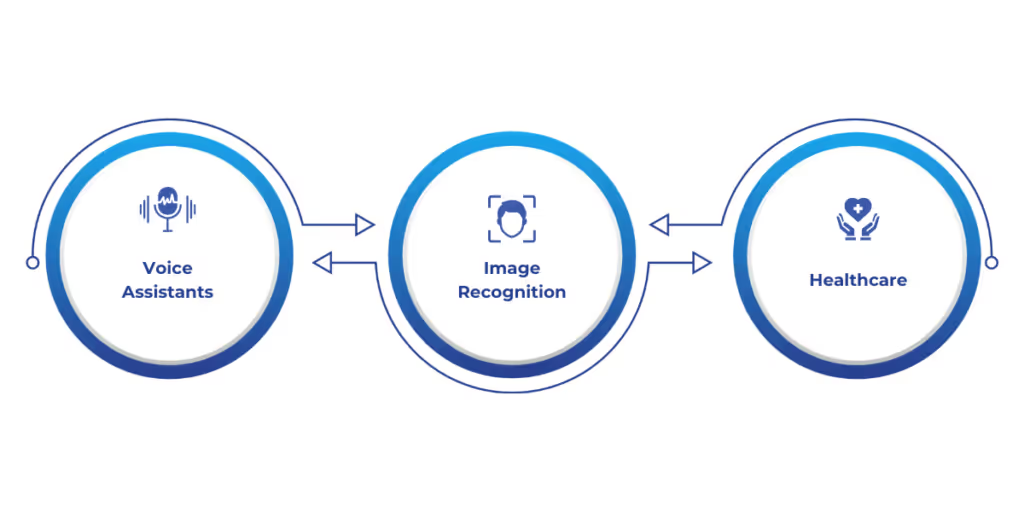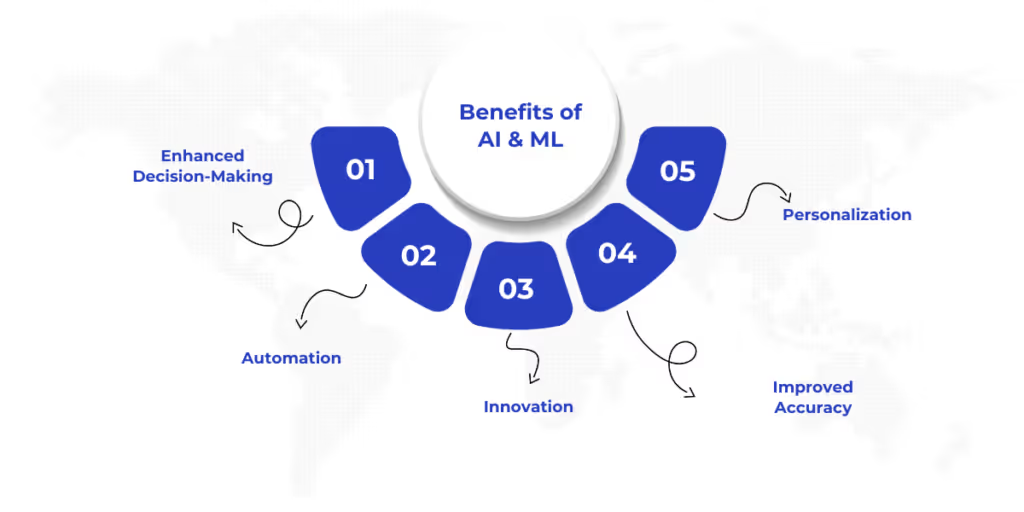


In the not-so-distant future, machines will not only assist us—they’ll think, learn, and evolve with us. Imagine a world where your voice assistant not only answers questions but understands your mood and preferences. Where your car drives itself with precision, anticipating obstacles before you even see them.
Welcome to the age of Artificial Intelligence (AI) and Machine Learning (ML), two transformative technologies reshaping how we live, work, and interact with the world.
The AI market is expected to grow to a size of $243.72 billion by 2025. On the other hand, the ML market is projected to reach $113.11 billion in the same year.
Though often used interchangeably, AI and ML are distinct complementary fields. AI is the broader goal of creating machines that simulate human intelligence, while ML powers these systems by enabling them to learn from data.
Understanding how they differ - and work together—is key to recognizing their potential.
In this article, we’ll dive deep into the fascinating world of AI and ML, uncovering their differences, and highlighting the incredible ways they’re driving innovation.
Artificial Intelligence refers to machines or systems designed to perform tasks that typically require human intelligence, such as decision-making, problem-solving, and language understanding. AI’s ultimate goal is to create systems that can think and reason like humans.
Machine Learning, a subset of AI, focuses on systems that learn from data and improve over time. Rather than relying on explicit instructions, ML algorithms identify patterns in data and adapt accordingly. While AI aims to replicate human cognitive functions, ML is the method by which AI achieves this goal.
Understanding these foundational concepts sets the stage for exploring the nuanced distinctions between AI and ML, which will help clarify their individual roles in driving technological advancements.
Here's a table highlighting the key differences between AI and ML:
AspectArtificial IntelligenceMachine LearningDefinitionThe broad concept focused on creating intelligent machines that can simulate human behavior and cognitive functions.A subset of AI that focuses on algorithms and models that allow systems to learn and improve from data.GoalEnable machines to perform tasks that typically require human intelligence (e.g., decision-making, problem-solving).Enable machines to learn from data and improve over time without being explicitly programmed for every task.ScopeEncompasses various techniques including reasoning, problem-solving, planning, robotics, and natural language processing.Focuses specifically on data-driven learning and pattern recognition through algorithms.MethodologyUses a variety of techniques like logic, decision trees, and neural networks to simulate human-like decision-making.Primarily uses statistical methods, algorithms, and data to identify patterns and make predictions.Dependency on DataAI may not always require data to function, depending on the task (e.g., rule-based systems).Relies heavily on data to train and improve models.ComplexityBroader and more complex; aims to replicate the full range of human cognitive abilities.More focused on specific tasks and learning from data.ExamplesSelf-driving cars, robotics, virtual assistants (e.g., Siri, Alexa), expert systems.Spam filters, recommendation systems (e.g., Netflix, Amazon), fraud detection.ApplicationsHealthcare diagnosis, natural language understanding, decision-making systems, autonomous systems.Predictive analytics, anomaly detection, image recognition, clustering.Techniques UsedNeural networks, expert systems, rule-based systems, and symbolic reasoning.Supervised learning, unsupervised learning, reinforcement learning.RelationshipAI often uses ML as a tool to enhance its ability to make decisions and learn from data.ML is a crucial part of AI, enabling machines to learn and improve autonomously.
This comparison highlights the distinct yet complementary roles that AI and ML play in the development of intelligent systems, laying the foundation for understanding how they work together.
Also Read: AI and Machine Learning in Predictive Analytics
AI and ML are deeply interconnected. In fact, automating middle-office tasks with AI and ML is expected to save North American banks $70 billion by 2025. While AI provides the overarching framework for intelligent systems, ML enhances these systems by enabling them to learn from data and improve autonomously.
AI Leverages ML: AI systems often use ML to enhance capabilities like:
Role of ML in AI: Machine Learning algorithms allow AI systems to:
Examples of AI and ML Working Together:

Through ML, AI systems become more adaptive and efficient, amplifying their capabilities and enabling advanced automation, personalization, and decision-making across various industries.
As AI and ML work in tandem to enhance each other’s capabilities, it's important to understand how these technologies are implemented and what techniques drive their success in real-world applications.
AI employs advanced techniques to replicate human intelligence. Some include:
ML focuses on models that enable systems to learn from data. Key methods include:
Both AI and ML enhance decision-making and problem-solving through these techniques, improving system performance over time.
These implementations and techniques form the backbone of AI and ML's practical applications, which span a wide range of industries and services.
Also Read: 6 Easy Steps to Use AI in Data Analysis
AI and ML have revolutionized many industries, including:
Beyond their applications, the benefits of AI and ML are becoming increasingly apparent, offering significant improvements in decision-making and operational efficiency.

AI and ML contribute significantly to efficiency and decision-making:
As AI and ML continue to evolve, their future prospects hold even more promise, with emerging technologies poised to take them to the next level.
The future of AI and ML is promising. Major U.S. tech companies, including Amazon, Alphabet, Microsoft, and Meta, plan to invest over $300 billion in AI infrastructure in 2025.
As computing power increases, these technologies will solve more complex problems. Emerging trends like the integration of AI with the Internet of Things (IoT) and the development of explainable AI will drive further innovations.
The fusion of AI, ML, and other emerging technologies such as blockchain, quantum computing, and 5G will accelerate AI adoption across industries.
Though distinct, AI and ML work together to create intelligent systems that enhance human-like decision-making and adaptability. As they continue to evolve, these technologies will have an increasing impact on industries ranging from healthcare to finance and beyond.
The continued development of AI and ML promises even greater advancements in automation, efficiency, and innovation, shaping our world in profound ways.
Ready to harness the power of Artificial Intelligence and Machine Learning for your business?
Explore cutting-edge solutions at WaferWire and accelerate your journey toward smarter, data-driven decision-making.
Visit now to discover how our innovative technologies can transform your operations and drive growth!

